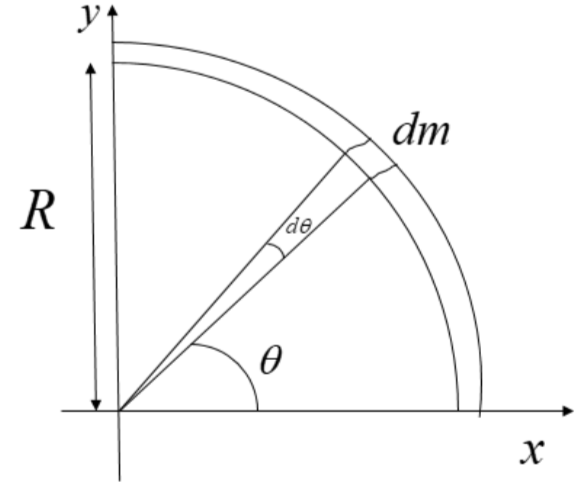
Find coordinates of the center of mass of a quarter ring of radius placed in the first quadrant of a Cartesian coordinate system, with center at the origin.
Answer
514.6k+ views
Hint: Quarter ring indicates that we need to find the center of mass for one-fourth of the ring placed in the first quadrant. We will find the general expression of coordinates of a small part of the ring. Finally, we will integrate it to find the required coordinates using the basic formula.
Formula Used:
${{X}_{CM}}=\dfrac{1}{M}\int{xdm}$
${{Y}_{CM}}=\dfrac{1}{M}\int{ydm}$
Complete step-by-step solution:
Here, we need to find the coordinates of the centre of mass of one fourth of a ring placed in the first quadrant. We will assume the origin as the centre of the circle, of which the ring is a part of, and then we can draw the diagram as follows:

Here, consider a one fourth ring present in the first quadrant having a total mass $M$ and radius $R$ and subtending a total angle of $\dfrac{\pi }{2}$ at the origin.
To find the centre of mass, consider a small portion of the ring at an angle $\theta $ from the x-axis. Let the mass of this portion be $dm$ of length $l$ and the angle subtended by this portion at the origin be $d\theta $.
Here, we will find the $x$ as well as $y$ component of the centre of mass and hence the coordinates of centre of mass.
Here, the total mass $M$ subtends an angle of $\dfrac{\pi }{2}$. Also, the mass $dm$ subtends an angle of $d\theta $
Hence, the mass $dm$can be written as:
$dm=\dfrac{M}{\left( \pi /2 \right)}\times d\theta $ ----(i)
Also, the length of the mass $dm$ can be written as:
$d\theta =\dfrac{l}{R}$
$\Rightarrow l=Rd\theta $ ----(ii)
Also, at any angle $\theta $ the general x coordinate and y coordinate can be written as:
$x=R\cos \theta $
$y=R\sin \theta $
For x coordinate:
${{X}_{CM}}=\dfrac{1}{M}\int{xdm}$
$\Rightarrow {{X}_{CM}}=\dfrac{1}{M}\int{R\cos \theta dm}$
From equation (i)
$\Rightarrow {{X}_{CM}}=\dfrac{1}{M}\int{R\cos \theta \dfrac{M}{(\pi /2)}\times d\theta }$
$\Rightarrow {{X}_{CM}}=\dfrac{2R}{\pi }\int\limits_{0}^{\pi /2}{\cos \theta d\theta }$
$\Rightarrow {{X}_{CM}}=\dfrac{2R}{\pi }$
For y coordinate:
${{Y}_{CM}}=\dfrac{1}{M}\int{ydm}$
$\Rightarrow {{Y}_{CM}}=\dfrac{1}{M}\int{R\sin \theta dm}$
From equation (i)
${{Y}_{CM}}=\dfrac{1}{M}\int{R\sin \theta \dfrac{M}{(\pi /2)}d\theta }$
$\Rightarrow {{Y}_{CM}}=\dfrac{2R}{\pi }\int\limits_{0}^{\pi /2}{\sin \theta d\theta }$
$\Rightarrow {{Y}_{CM}}=\dfrac{2R}{\pi }$
Hence, the coordinates of the centre of mass of a quarter ring placed in the first quadrant is $({{X}_{CM}},{{Y}_{CM}})=(\dfrac{2R}{\pi },\dfrac{2R}{\pi })$.
Note: To find centre of mass, always take a small mass into consideration. Find out the general equation for the x and y coordinate for that small part. Then use the basic formula to find the coordinates of the centre of mass.
Formula Used:
${{X}_{CM}}=\dfrac{1}{M}\int{xdm}$
${{Y}_{CM}}=\dfrac{1}{M}\int{ydm}$
Complete step-by-step solution:
Here, we need to find the coordinates of the centre of mass of one fourth of a ring placed in the first quadrant. We will assume the origin as the centre of the circle, of which the ring is a part of, and then we can draw the diagram as follows:

Here, consider a one fourth ring present in the first quadrant having a total mass $M$ and radius $R$ and subtending a total angle of $\dfrac{\pi }{2}$ at the origin.
To find the centre of mass, consider a small portion of the ring at an angle $\theta $ from the x-axis. Let the mass of this portion be $dm$ of length $l$ and the angle subtended by this portion at the origin be $d\theta $.
Here, we will find the $x$ as well as $y$ component of the centre of mass and hence the coordinates of centre of mass.
Here, the total mass $M$ subtends an angle of $\dfrac{\pi }{2}$. Also, the mass $dm$ subtends an angle of $d\theta $
Hence, the mass $dm$can be written as:
$dm=\dfrac{M}{\left( \pi /2 \right)}\times d\theta $ ----(i)
Also, the length of the mass $dm$ can be written as:
$d\theta =\dfrac{l}{R}$
$\Rightarrow l=Rd\theta $ ----(ii)
Also, at any angle $\theta $ the general x coordinate and y coordinate can be written as:
$x=R\cos \theta $
$y=R\sin \theta $
For x coordinate:
${{X}_{CM}}=\dfrac{1}{M}\int{xdm}$
$\Rightarrow {{X}_{CM}}=\dfrac{1}{M}\int{R\cos \theta dm}$
From equation (i)
$\Rightarrow {{X}_{CM}}=\dfrac{1}{M}\int{R\cos \theta \dfrac{M}{(\pi /2)}\times d\theta }$
$\Rightarrow {{X}_{CM}}=\dfrac{2R}{\pi }\int\limits_{0}^{\pi /2}{\cos \theta d\theta }$
$\Rightarrow {{X}_{CM}}=\dfrac{2R}{\pi }$
For y coordinate:
${{Y}_{CM}}=\dfrac{1}{M}\int{ydm}$
$\Rightarrow {{Y}_{CM}}=\dfrac{1}{M}\int{R\sin \theta dm}$
From equation (i)
${{Y}_{CM}}=\dfrac{1}{M}\int{R\sin \theta \dfrac{M}{(\pi /2)}d\theta }$
$\Rightarrow {{Y}_{CM}}=\dfrac{2R}{\pi }\int\limits_{0}^{\pi /2}{\sin \theta d\theta }$
$\Rightarrow {{Y}_{CM}}=\dfrac{2R}{\pi }$
Hence, the coordinates of the centre of mass of a quarter ring placed in the first quadrant is $({{X}_{CM}},{{Y}_{CM}})=(\dfrac{2R}{\pi },\dfrac{2R}{\pi })$.
Note: To find centre of mass, always take a small mass into consideration. Find out the general equation for the x and y coordinate for that small part. Then use the basic formula to find the coordinates of the centre of mass.
Recently Updated Pages
Why are manures considered better than fertilizers class 11 biology CBSE

Find the coordinates of the midpoint of the line segment class 11 maths CBSE

Distinguish between static friction limiting friction class 11 physics CBSE

The Chairman of the constituent Assembly was A Jawaharlal class 11 social science CBSE

The first National Commission on Labour NCL submitted class 11 social science CBSE

Number of all subshell of n + l 7 is A 4 B 5 C 6 D class 11 chemistry CBSE

Trending doubts
What is meant by exothermic and endothermic reactions class 11 chemistry CBSE

10 examples of friction in our daily life

One Metric ton is equal to kg A 10000 B 1000 C 100 class 11 physics CBSE

1 Quintal is equal to a 110 kg b 10 kg c 100kg d 1000 class 11 physics CBSE

Difference Between Prokaryotic Cells and Eukaryotic Cells

What are Quantum numbers Explain the quantum number class 11 chemistry CBSE




